Abstract
STUDY OBJECTIVE--To examine trends in socioeconomic inequalities in cardiovascular risk factors using educational attainment to indicate socioeconomic status. DESIGN--Behavioural data, physical measurements, blood pressure, and lipid determination collected in three, successive multicentre cross sectional community surveys conducted in 1980, 1983, and 1989. SETTING--The six state capital cities of Australia; Sydney, Melbourne, Brisbane, Adelaide, Perth, and Hobart. PARTICIPANTS--A total of 19,315 randomly selected respondents stratified by age (25-44, 45-64) and sex. RESULTS--During the 1980s, average blood pressure declined for each level of educational attainment. Dietary messages to reduce the intake of saturated fat had little effect on the lipid profile of any population group. Height and educational attainment were positively associated. Women increased in weight from between 2 to 4 kg depending on age and educational attainment while older men experienced increases of around 2.5 kg regardless of educational attainment. Advice to avoid salt was adopted across the spectrum of educational attainment but with no suggestion that the socioeconomic gradient, which favoured the more highly educated, was diminishing. Men of all education levels responded positively to the anti-smoking initiatives of the 1980s but the relative disadvantage of those of lower education was maintained. Among women, the decline in smoking was less among those in the low education group. The prevalence of moderate to heavy drinkers was higher in men of lower educational attainment but declined significantly over the period. Walking for recreation or exercise became more popular, especially among older men of low education, while the prevalence of aerobic exercise and vigorous exercise remained largely unchanged. Overall, the clear socioeconomic gradient between leisure time physical activity and education attainment remained. CONCLUSIONS--The lower socioeconomic group has improved its risk factor profile but its relative disadvantage compared with the higher socioeconomic group persists. Health promotion activities in Australia seem to have been effective in reaching the lower socioeconomic groups but the challenge to reduce inequalities remains. The steady increase in educational attainment in Australia may have been an important factor in the general improvement in the nation's risk factor profile and in the decrease in mortality from coronary heart disease.
Full text
PDF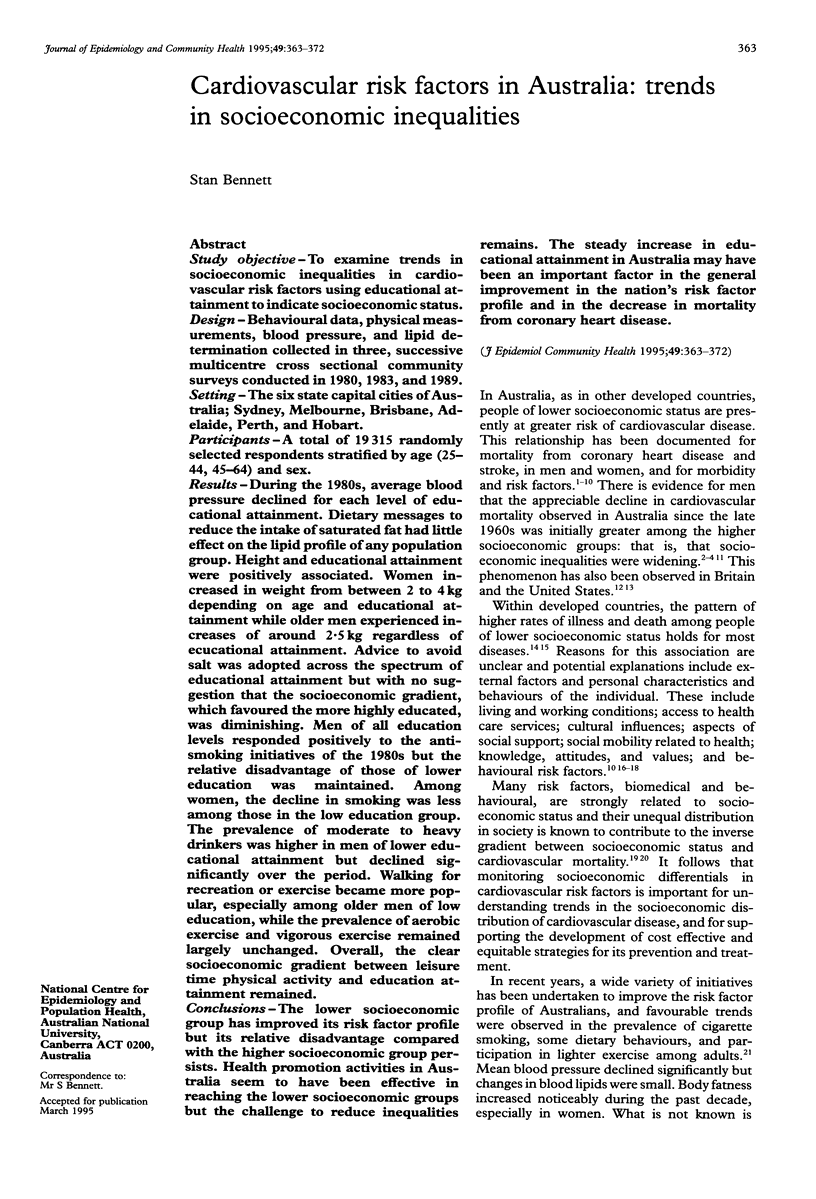
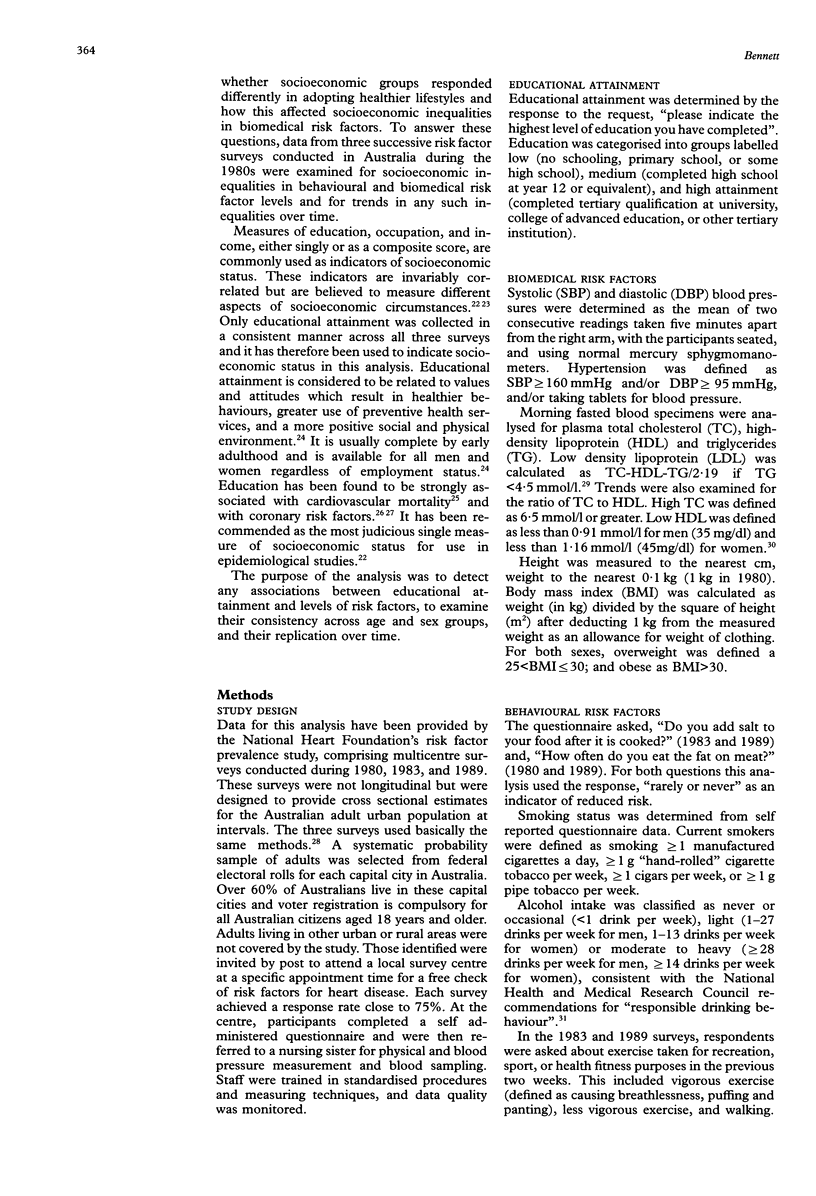
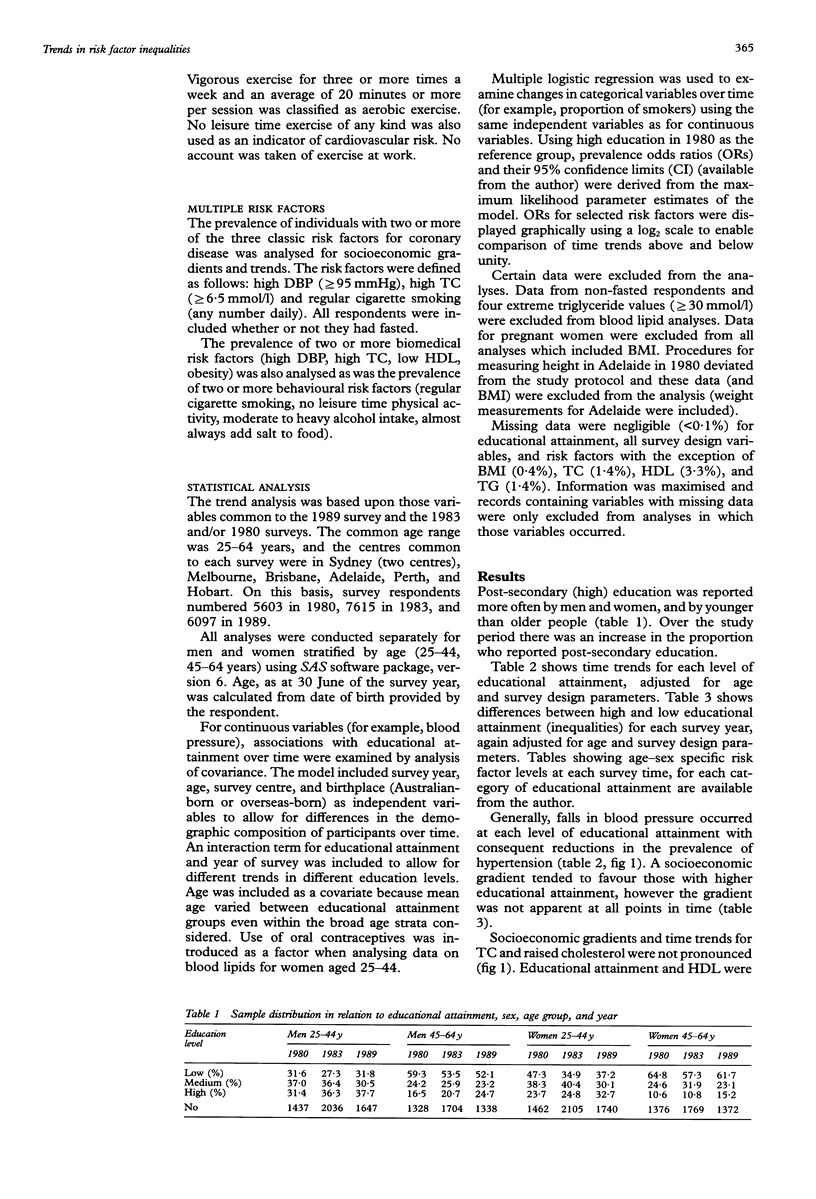
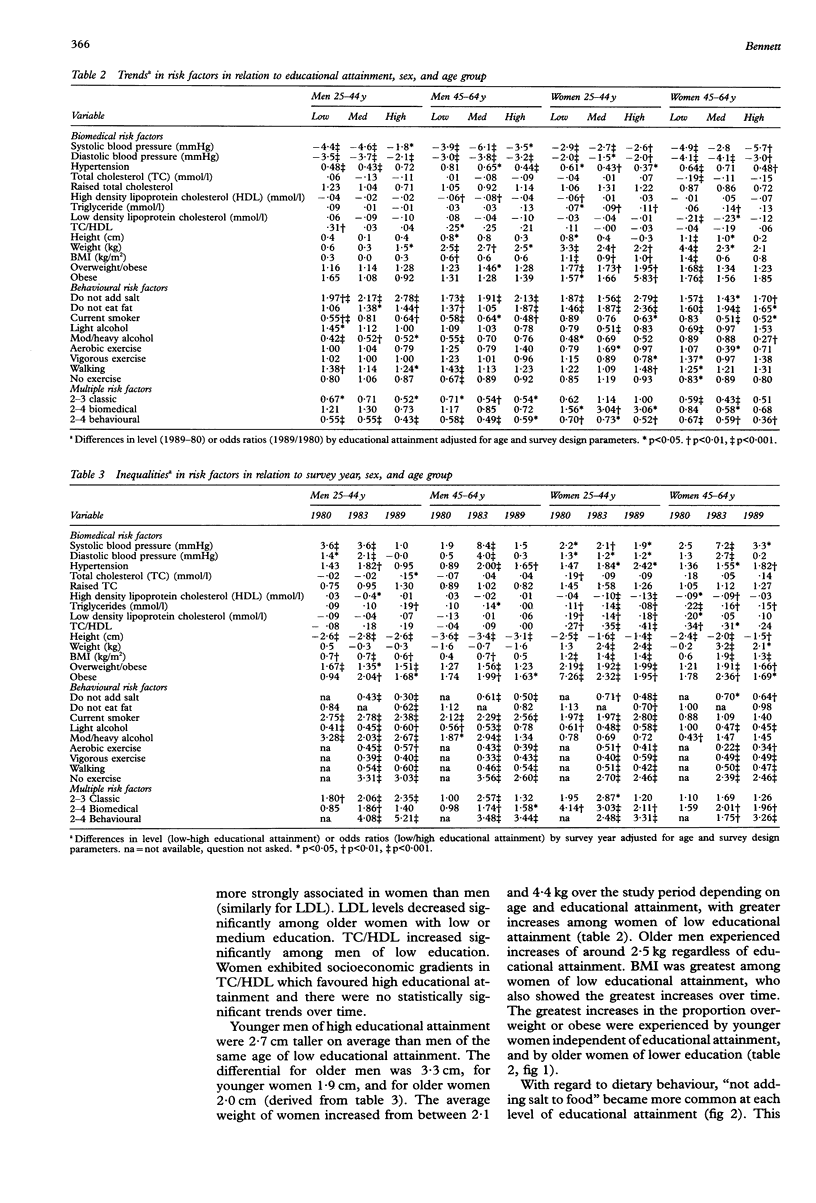
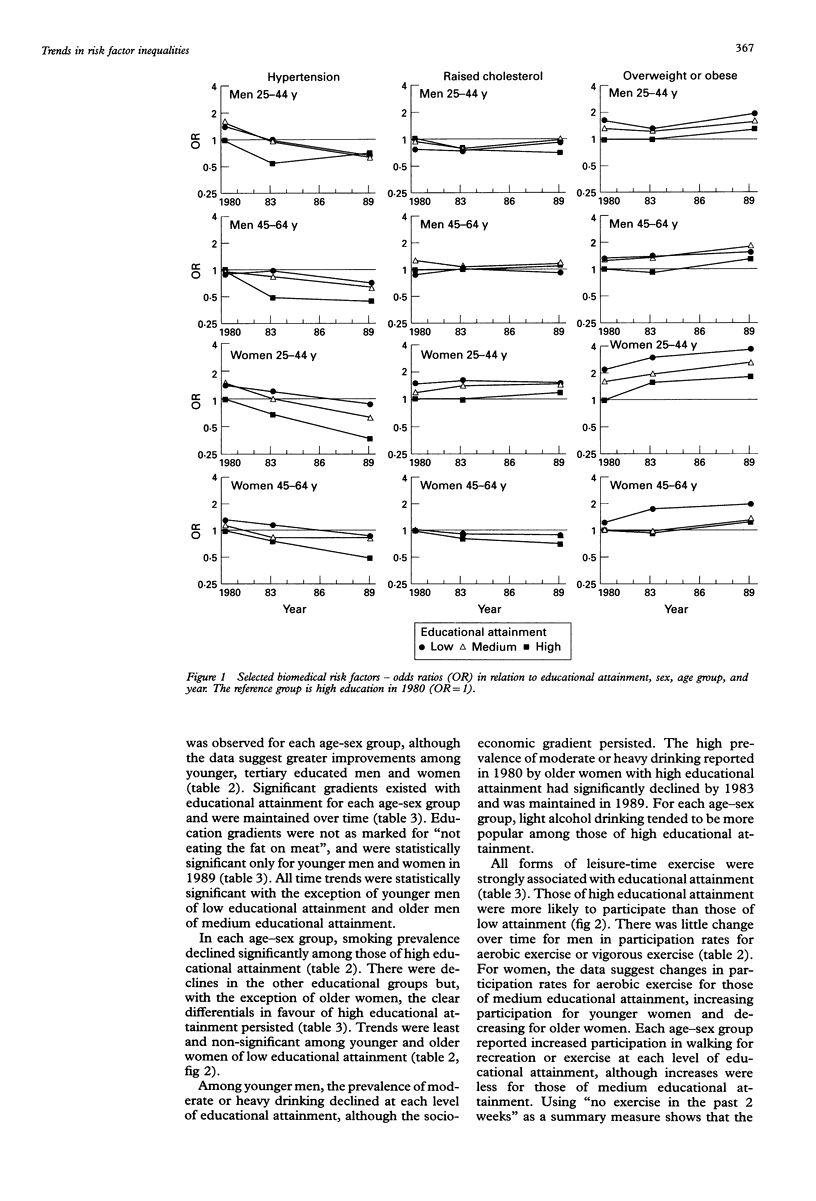
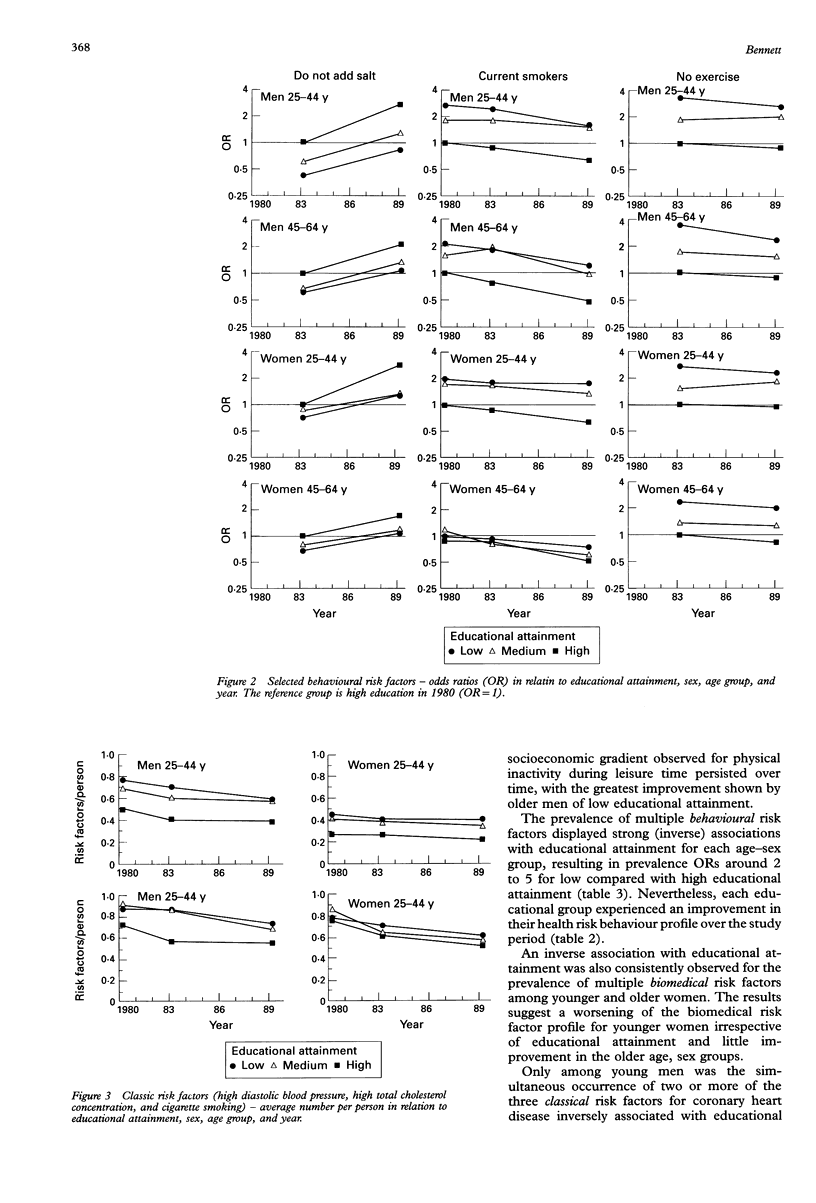
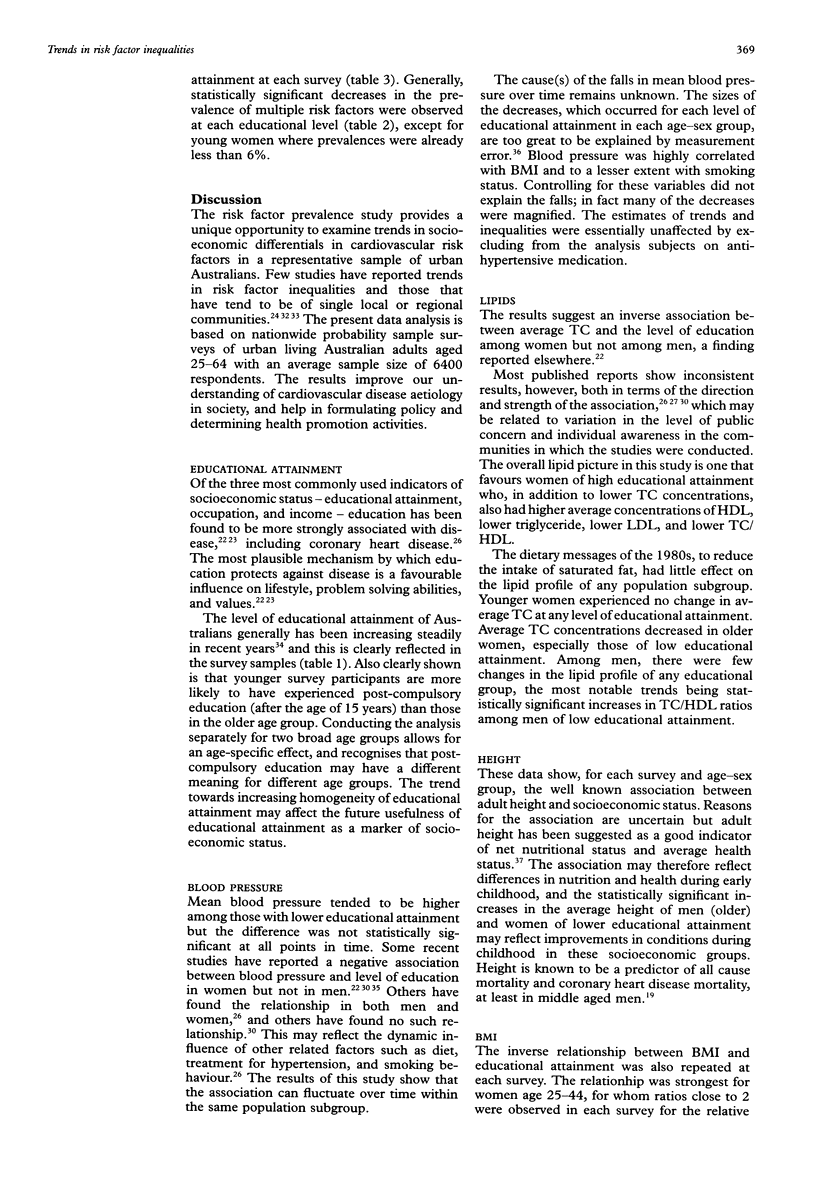

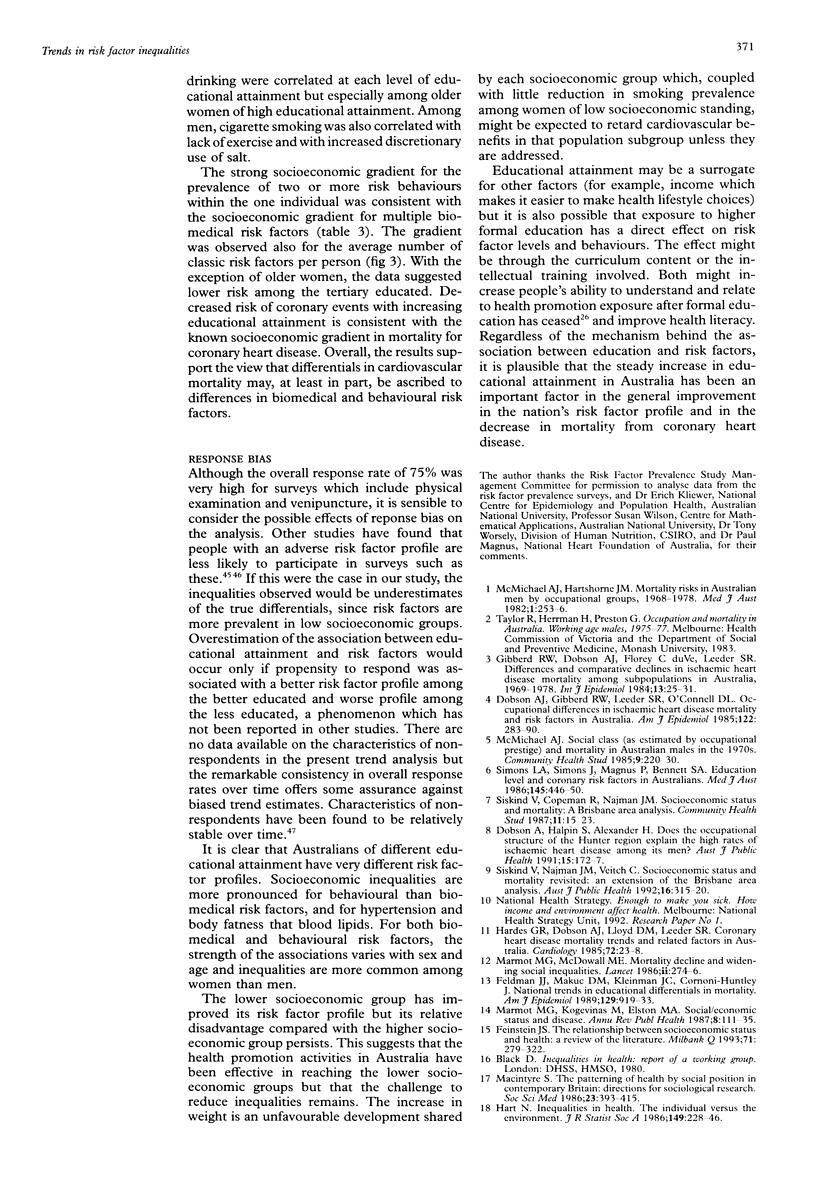
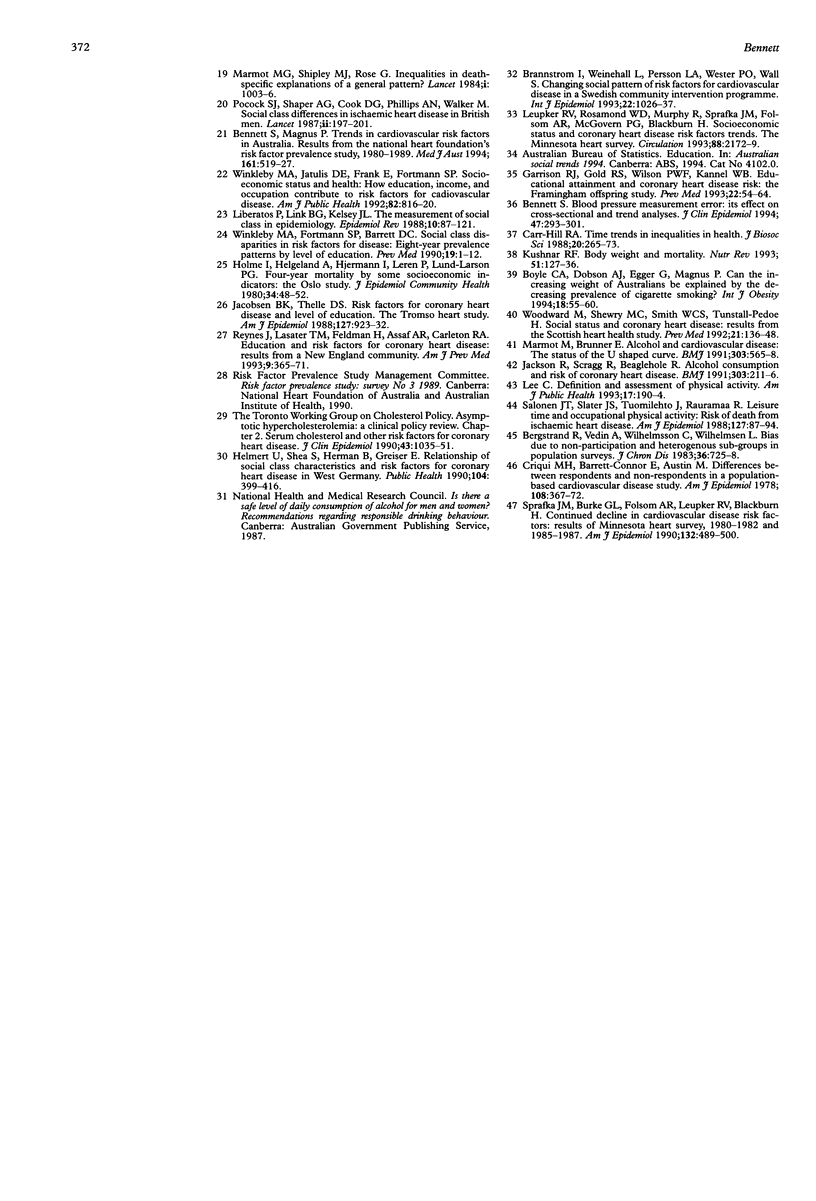
Selected References
These references are in PubMed. This may not be the complete list of references from this article.
- Bennett S. A., Magnus P. Trends in cardiovascular risk factors in Australia. Results from the National Heart Foundation's Risk Factor Prevalence Study, 1980-1989. Med J Aust. 1994 Nov 7;161(9):519–527. [PubMed] [Google Scholar]
- Bennett S. Blood pressure measurement error: its effect on cross-sectional and trend analyses. J Clin Epidemiol. 1994 Mar;47(3):293–301. doi: 10.1016/0895-4356(94)90010-8. [DOI] [PubMed] [Google Scholar]
- Bergstrand R., Vedin A., Wilhelmsson C., Wilhelmsen L. Bias due to non-participation and heterogenous sub-groups in population surveys. J Chronic Dis. 1983;36(10):725–728. doi: 10.1016/0021-9681(83)90166-2. [DOI] [PubMed] [Google Scholar]
- Boyle C. A., Dobson A. J., Egger G., Magnus P. Can the increasing weight of Australians be explained by the decreasing prevalence of cigarette smoking? Int J Obes Relat Metab Disord. 1994 Jan;18(1):55–60. [PubMed] [Google Scholar]
- Brännström I., Weinehall L., Persson L. A., Wester P. O., Wall S. Changing social patterns of risk factors for cardiovascular disease in a Swedish community intervention programme. Int J Epidemiol. 1993 Dec;22(6):1026–1037. doi: 10.1093/ije/22.6.1026. [DOI] [PubMed] [Google Scholar]
- Carr-Hill R. A. Time trends in inequalities in health. J Biosoc Sci. 1988 Jul;20(3):265–273. doi: 10.1017/s002193200000660x. [DOI] [PubMed] [Google Scholar]
- Criqui M. H., Barrett-Connor E., Austin M. Differences between respondents and non-respondents in a population-based cardiovascular disease study. Am J Epidemiol. 1978 Nov;108(5):367–372. doi: 10.1093/oxfordjournals.aje.a112633. [DOI] [PubMed] [Google Scholar]
- Dobson A. J., Gibberd R. W., Leeder S. R., O'Connell D. L. Occupational differences in ischemic heart disease mortality and risk factors in Australia. Am J Epidemiol. 1985 Aug;122(2):283–290. doi: 10.1093/oxfordjournals.aje.a114100. [DOI] [PubMed] [Google Scholar]
- Dobson A., Halpin S., Alexander H. Does the occupational structure of the Hunter Region explain the high rates of ischaemic heart disease among its men? Aust J Public Health. 1991 Sep;15(3):172–177. doi: 10.1111/j.1753-6405.1991.tb00331.x. [DOI] [PubMed] [Google Scholar]
- Feinstein J. S. The relationship between socioeconomic status and health: a review of the literature. Milbank Q. 1993;71(2):279–322. [PubMed] [Google Scholar]
- Feldman J. J., Makuc D. M., Kleinman J. C., Cornoni-Huntley J. National trends in educational differentials in mortality. Am J Epidemiol. 1989 May;129(5):919–933. doi: 10.1093/oxfordjournals.aje.a115225. [DOI] [PubMed] [Google Scholar]
- Garrison R. J., Gold R. S., Wilson P. W., Kannel W. B. Educational attainment and coronary heart disease risk: the Framingham Offspring Study. Prev Med. 1993 Jan;22(1):54–64. doi: 10.1006/pmed.1993.1004. [DOI] [PubMed] [Google Scholar]
- Gibberd R. W., Dobson A. J., Florey C. D., Leeder S. R. Differences and comparative declines in ischaemic heart disease mortality among subpopulations in Australia, 1969-1978. Int J Epidemiol. 1984 Mar;13(1):25–31. doi: 10.1093/ije/13.1.25. [DOI] [PubMed] [Google Scholar]
- Hardes G. R., Dobson A. J., Lloyd D. M., Leeder S. R. Coronary heart disease mortality trends and related factors in Australia. Cardiology. 1985;72(1-2):23–28. doi: 10.1159/000173837. [DOI] [PubMed] [Google Scholar]
- Helmert U., Shea S., Herman B., Greiser E. Relationship of social class characteristics and risk factors for coronary heart disease in West Germany. Public Health. 1990 Nov;104(6):399–416. doi: 10.1016/s0033-3506(05)80083-6. [DOI] [PubMed] [Google Scholar]
- Holme I., Helgeland A., Hjermann I., Leren P., Lund-Larsen P. G. Four-year mortality by some socioeconomic indicators: the Oslo study. J Epidemiol Community Health. 1980 Mar;34(1):48–52. doi: 10.1136/jech.34.1.48. [DOI] [PMC free article] [PubMed] [Google Scholar]
- Jacobsen B. K., Thelle D. S. Risk factors for coronary heart disease and level of education. The Tromsø Heart Study. Am J Epidemiol. 1988 May;127(5):923–932. doi: 10.1093/oxfordjournals.aje.a114895. [DOI] [PubMed] [Google Scholar]
- Kushner R. F. Body weight and mortality. Nutr Rev. 1993 May;51(5):127–136. doi: 10.1111/j.1753-4887.1993.tb03089.x. [DOI] [PubMed] [Google Scholar]
- Liberatos P., Link B. G., Kelsey J. L. The measurement of social class in epidemiology. Epidemiol Rev. 1988;10:87–121. doi: 10.1093/oxfordjournals.epirev.a036030. [DOI] [PubMed] [Google Scholar]
- Luepker R. V., Rosamond W. D., Murphy R., Sprafka J. M., Folsom A. R., McGovern P. G., Blackburn H. Socioeconomic status and coronary heart disease risk factor trends. The Minnesota Heart Survey. Circulation. 1993 Nov;88(5 Pt 1):2172–2179. doi: 10.1161/01.cir.88.5.2172. [DOI] [PubMed] [Google Scholar]
- Macintyre S. The patterning of health by social position in contemporary Britain: directions for sociological research. Soc Sci Med. 1986;23(4):393–415. doi: 10.1016/0277-9536(86)90082-1. [DOI] [PubMed] [Google Scholar]
- Marmot M. G., McDowall M. E. Mortality decline and widening social inequalities. Lancet. 1986 Aug 2;2(8501):274–276. doi: 10.1016/s0140-6736(86)92085-4. [DOI] [PubMed] [Google Scholar]
- Marmot M. G., Shipley M. J., Rose G. Inequalities in death--specific explanations of a general pattern? Lancet. 1984 May 5;1(8384):1003–1006. doi: 10.1016/s0140-6736(84)92337-7. [DOI] [PubMed] [Google Scholar]
- Marmot M., Brunner E. Alcohol and cardiovascular disease: the status of the U shaped curve. BMJ. 1991 Sep 7;303(6802):565–568. doi: 10.1136/bmj.303.6802.565. [DOI] [PMC free article] [PubMed] [Google Scholar]
- McMichael A. J., Hartshorne J. M. Mortality risks in Australian men by occupational groups, 1968-1978: variations associated with differences in drinking and smoking habits. Med J Aust. 1982 Mar 20;1(6):253–256. [PubMed] [Google Scholar]
- McMichael A. J. Social class (as estimated by occupational prestige) and mortality in Australian males in the 1970s. Community Health Stud. 1985;9(3):220–230. doi: 10.1111/j.1753-6405.1985.tb00489.x. [DOI] [PubMed] [Google Scholar]
- Pocock S. J., Shaper A. G., Cook D. G., Phillips A. N., Walker M. Social class differences in ischaemic heart disease in British men. Lancet. 1987 Jul 25;2(8552):197–201. doi: 10.1016/s0140-6736(87)90774-4. [DOI] [PubMed] [Google Scholar]
- Reynes J. F., Lasater T. M., Feldman H., Assaf A. R., Carleton R. A. Education and risk factors for coronary heart disease: results from a New England community. Am J Prev Med. 1993 Nov-Dec;9(6):365–371. [PubMed] [Google Scholar]
- Salonen J. T., Slater J. S., Tuomilehto J., Rauramaa R. Leisure time and occupational physical activity: risk of death from ischemic heart disease. Am J Epidemiol. 1988 Jan;127(1):87–94. doi: 10.1093/oxfordjournals.aje.a114794. [DOI] [PubMed] [Google Scholar]
- Simons L. A., Simons J., Magnus P., Bennett S. A. Education level and coronary risk factors in Australians. Med J Aust. 1986 Nov 3;145(9):446, 448-50. doi: 10.5694/j.1326-5377.1986.tb113870.x. [DOI] [PubMed] [Google Scholar]
- Siskind V., Copeman R., Najman J. M. Socioeconomic status and mortality: a Brisbane area analysis. Community Health Stud. 1987;11(1):15–23. doi: 10.1111/j.1753-6405.1987.tb00126.x. [DOI] [PubMed] [Google Scholar]
- Siskind V., Najman J. M., Veitch C. Socioeconomic status and mortality revisited: an extension of the Brisbane area analysis. Aust J Public Health. 1992 Sep;16(3):315–320. doi: 10.1111/j.1753-6405.1992.tb00072.x. [DOI] [PubMed] [Google Scholar]
- Sprafka J. M., Burke G. L., Folsom A. R., Luepker R. V., Blackburn H. Continued decline in cardiovascular disease risk factors: results of the Minnesota Heart Survey, 1980-1982 and 1985-1987. Am J Epidemiol. 1990 Sep;132(3):489–500. doi: 10.1093/oxfordjournals.aje.a115685. [DOI] [PubMed] [Google Scholar]
- Winkleby M. A., Fortmann S. P., Barrett D. C. Social class disparities in risk factors for disease: eight-year prevalence patterns by level of education. Prev Med. 1990 Jan;19(1):1–12. doi: 10.1016/0091-7435(90)90001-z. [DOI] [PubMed] [Google Scholar]
- Winkleby M. A., Jatulis D. E., Frank E., Fortmann S. P. Socioeconomic status and health: how education, income, and occupation contribute to risk factors for cardiovascular disease. Am J Public Health. 1992 Jun;82(6):816–820. doi: 10.2105/ajph.82.6.816. [DOI] [PMC free article] [PubMed] [Google Scholar]
- Woodward M., Shewry M. C., Smith W. C., Tunstall-Pedoe H. Social status and coronary heart disease: results from the Scottish Heart Health Study. Prev Med. 1992 Jan;21(1):136–148. doi: 10.1016/0091-7435(92)90013-8. [DOI] [PubMed] [Google Scholar]


